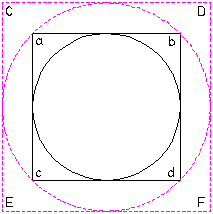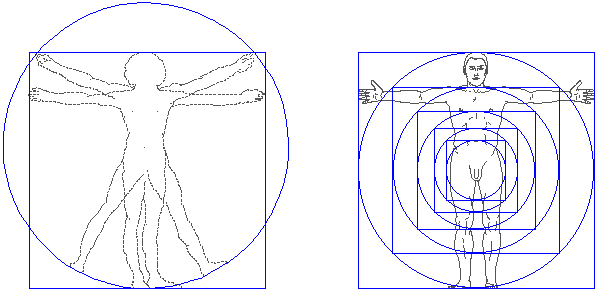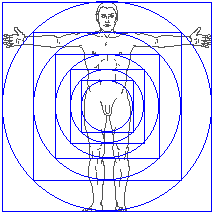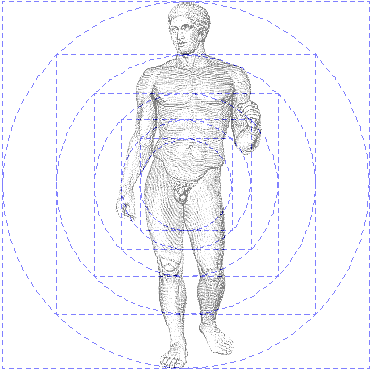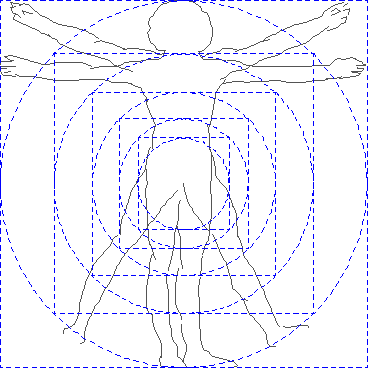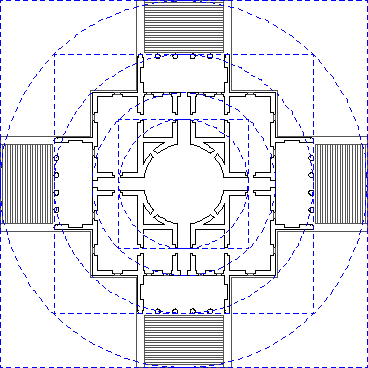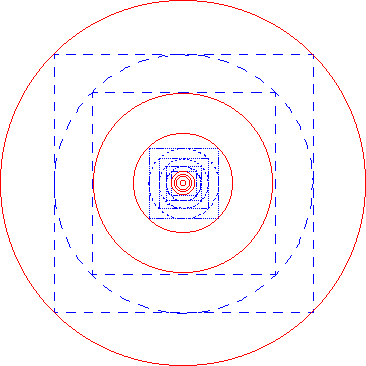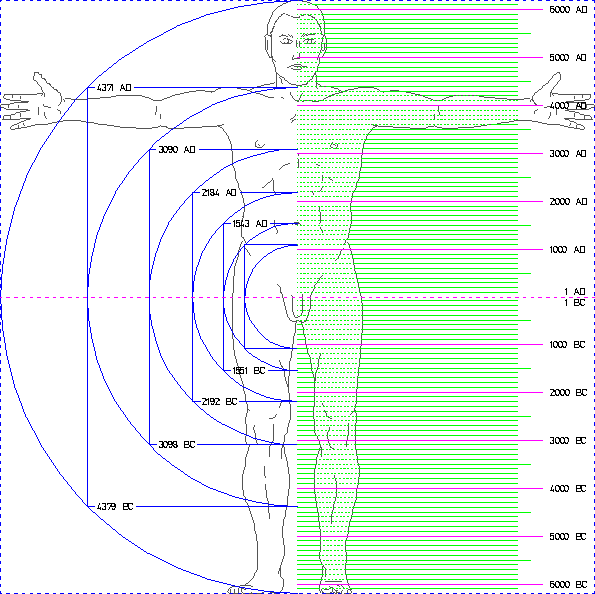1995.07.24 | The Timepiece of Humanity |
Stephen Lauf
|
The Gauge
The Timepiece of Humanity continues the tradition of relating the human body to ideal form, and, in particular, elaborates on the body's relationship to circles and squares1. There is a little known geometric principle where the combination of a circle and a square facilitates the drawing of a second circle or square exactly twice the area of the first circle or square. For example, if a circle is tangent to the four inner sides of a square, a second circle, touching the four corners of the same square, is exactly twice the area of the first circle. Likewise, a second square, whose four sides are tangential to the second circle, is twice the area of the first square. This progression can go on infinitely, both outwardly and inwardly: each new circle or square will be either double the area of the circle or square before it, or half the area of the circle or square after it. The diagram itself is also visually satisfying, presenting a single point of origin and an endless expansion. It suggests the ripples created by a stone thrown into a pond, as well as, the solar system's concentric orbits.
|
1. |
|
The second revelation of this diagrammatic gauge is the system of corporal order that is otherwise imperceptible. Each of the body's major elements and demarcations correspond directly to the points of circle/square juncture. The position of the knees, the testicles, the navel, the nipples, the arms, and the head all relate to the geometric network. The sequence of junctures, likewise, corresponds to aspects of the human body's internal makeup. The ovaries relate to a juncture, as do both the upper end of the intestines and the transitional membrane of the diaphragm. This order of the circle/square system is not exclusively related to the body, however. The same imperceptible order can be found in examples of art and architecture, as well as within the immediate cosmos.2 When the circle/square diagram is applied to Greek sculptures, Palladio's Villa Capra, and even Leonardo's Vitruvian man, there is again a direct correlation between the circle/square diagram and the physical makeup of each example. Likewise, the geometric system of consecutive circles and squares corresponds to the distance between the orbits of some planets in the solar system. The unseen presence of the circle/square geometry within these examples appears to express not only a forgotten knowledge, but also a natural order that is greater than the geometric principle itself.
Despite difficulty in squaring the report of Luke ii, I, with other records of Roman history, interpreters tend to agree that Jesus was born from four to seven years B.C.--i.e., "before Christ." The source of this anomaly is the reform of the calendar by Dionysius Exiguus, who set the date of "the incarnation of the Lord" as the year 753 after the founding of Rome. But Herod, into whose reign the Gospels place the birth of Jesus, died about 749 according to Roman reckoning, or 4 B.C.; and the census mentioned in the Christmas story of Luke seems to have happened in the year 747 by the Roman count, or 6 B.C. Somewhere between 4 and 7 B.C. is as close as modern research has been able to come in attempting to fix the date of Jesus' birth, and 4 B.C. is most commonly given.
The first step in calibrating the gauge, however, is to establish the position of the center firmly. Traditionally, Christ's birth is at the juncture of B.C. and A.D., where the first year of Christ's life corresponds to the year 1 A.D. Historiographic research, however, no longer agrees with this tradition, and current thinking places Christ's birth near the beginning of 4 B.C., December 25, 5 B.C. This chronological "inaccuracy" has no detrimental effect on the Timepiece, but it does necessitate the addition of four years to any time interval representing the "distance" between the center and the number of a year at a circle/square juncture. A chronological system without a year "zero," however, does present a slight problem. The year "zero" does not exist because the day before January 1, 1 A.D. is December 31, 1 B.C. This is an unfortunate way to measure anything since the elimination of zero complicates any simple calculation dealing with positive and negative numbers. Consequently, after the addition of four years to a year A.D., one year must then be subtracted to arrive at the exact amount of time between the center and any given year A.D. The Timepiece accepts 4 B.C. as the center, and adapts to the required mathematical adjustments.
An investigation of each newly calculated circle/square juncture's historical significance is now in order. For a juncture year to concur exactly with a significant event is, of course, preferable to even a very low degree of tolerance. The Timepiece of Humanity cannot, however, avoid the necessity for at least some tolerance, because its gauge is, to begin with, centered and based on an inexact date--Christ's birth. The proximity of a "test" circle/square date to a historical event, although important, is, nonetheless, secondary to whether, or not, the event manifests a shift, for humanity, from one phase to another. The historical event, if there is one, must be of a transitional nature, and hopefully at least one of the series of years will coincide with a high number of historical turning point events. The following three tables list the historical events linked to each set of calculated juncture years:
|
2. Each example here is superimposed with a diagrammatic series of circle/square junctures, and the direct relationship between the examples and the diagram is self evident. In the case of the orbital rings of the solar system, progressive circle/square junctures occur between the orbits of Venus and Earth, Mars and Jupiter, and Saturn and Neptune.
Polyclitus' Doryphorus
Leonardo da Vinci's Vitruvian Man
Andrea Palladio's Villa Capra
Part of the Solar System: |
|
AD BC
Most of the juncture years adequately synchronize with critical historic events, and the events themselves are persistently of a philosophic or religious nature. For example, one list includes the birth of Kung Fu-tzu (Confucius) while another list includes Plato's founding of the Academy in Athens, and, as to their importance, both events are practically synonymous with the origins of eastern and western philosophy. Likewise, there are many dates, from all three lists, that correspond to crucial points in Christianity's growth and development, and, of course, this is noteworthy because each list includes the birth of Christ as a given. The lists, however, also disclose a number of important religious events apart from Christianity. One list contains the birth of Siddhartha (Gautama Buddha), and dates on all three lists correspond to the subsequent spread of Buddhism. All these events are extremely promising in terms of establishing the Timepiece gauge, but the overall significance of the events collectively is that they are not at all random. Most of the events fall within interrelated groups and there is the emergence of a strong pattern involving origins, growth, and development.
|
|
|
Confucius was a Chinese sage, best known throughout his life as a teacher, and ultimately the founder of Confucianism. The three most important doctrines of Confucius concern benevolence, the superior man, and ritual propriety. The best description of the concept of benevolence comes from two of his sayings: "Do not to other what you would not like yourself"; and "Do unto other what you wish to do unto yourself."
Reviewing the situation, the third series of dates establishes the distance, in years, between Christ's birth at 4 B.C. and the publication of Copernicus' heliocentric theory, De revolutionibus orbium coelestium in 1543 A.D. to be 1546 years. Additionally, these two events equate with the body at the crotch and the navel, respectively. Of the juncture years that subsequently fall into place, 551 B.C. is, of course, the most crucial, since 551 B.C. coincides with the birth of Confucius, and 550 B.C. coincides with the birth of Buddha. For the births of a foremost world religious originator and the birth of a foremost world philosopher to fall on the same circle/square juncture carries tremendous weight in terms of the Timepiece gauge. The "co-births" add a another religion, Buddhism, plus a predominantly eastern philolophy to the Timepiece's otherwise overly Christian bent thus far, and, rather than negating the original premise of the Timepiece, the addition of the births of Confucius and Buddha to the gauge renders the Timepiece more globally inclusive. The influence of Confucius and Buddha holds the same weight, worldwide, as the influence of Jesus Christ. Besides corresponding to a circle/square juncture, 551 B.C. also corresponds to the testicles, and this somatic concurrence affords a new interpretation of the meaningfulness of Confucius and Buddha along physiological and morphological lines. Their teachings come to represent the "seeds" of humanity's moral consciousness, and just as there are two testicles, there are likewise two distinct, but equal, influences. This interpretation is a fitting continuation of the Timepiece of Humanity metaphor, and provides convincing evidence that a viable gauge may be at hand.
Theodosius I (347-395) began his reign as Roman Emperor over the eastern empire in 379 and over the western empire, as well, in 392. He was the first emperor to dispense with the old pagan title of pontifax maximus, and he established Catholicism as the state religion of the empire. A law issued on February 28, 380, ordered all the peoples of the realm to subscribe to the dogmas of Nicaea, the Catholic creed.
The other years of the 1543 A.D. series do not correspond to any distinct bodily features, at least not on the surface, but they do correspond to historical turning point events. The beginning of the written Bible and the philosophy of Plato, both occurring around 392 B.C., mark an ongoing development, or "new phase," of humanity's moral consciousness. On the other side of the center, the year 383 A.D. is within the reign of the Roman Emperor Theodosius (379 - 395), who established Catholicism as the state religion of the empire. Skipping the juncture at 544 A.D., the Christian theme continues around 770 A.D. The reign of Charlemagne began in 771, and he confirmed the Donation of Pepin in 774. The Donation of Pepin gave the papacy actual territory to govern, and thus the pope became a sovereign prince, attaining "temporal power" in addition to his "spiritual power." The next juncture year, 1091 A.D., is four years before Pope Urban II proclaims the first Crusade in 1095. These three juncture years, 383 A.D., 770 A.D., and 1091 A.D., chronicle a steady rise, and shift, in Catholicism's "temporal power," from becoming a state religion, to becoming a state itself, to ultimately waging war. The sequence does not end around 1091 A.D., however. Although the year 1543 A.D., in testing the calibration of the Timepiece gauge, represents the publication of Copernicus' heliocentric theory, another shift in Catholicism's "temporal power" is evident during this period as well. Pope Paul III established the Inquisition in Rome in 1542, and the Spanish Inquisition, with the first burning of Protestants at the stake, began in 1543. Catholicism's ultimate "rise" in temporal power actually manifested itself as an abuse of power.
|
3. |
3333s
| Quondam © 2014.05.02 |
